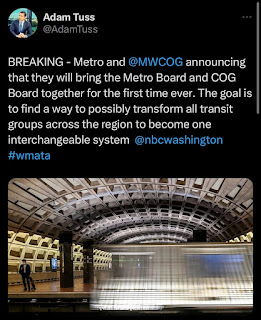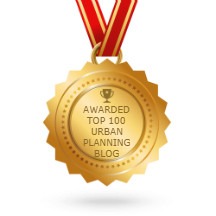WMATA and MWCOG announce new joint transit initiative | Could a regional "transport association" be on the horizon, or just a transit bailout?
According to Twitter and other news sources ("WMATA and MWCOG announce new joint transit initiative," DC News Now) WMATA the operator of regional subway and bus services, and the Metropolitan Washington Council of Governments, are going to start working together.
The COG is the union of local governments and designated by the USDOT as the region's metropolitan planning organization for regional transportation planning and coordination.
From the article:
In a news release sent out Wednesday, officials said that the organizations’ Boards of Directors will meet on May 1 to start “months-long discussions about how to efficiently provide, fund, and govern public transit.”
Funny of course, because this is driven by the financial pressures faced by WMATA foremost ("Facing massive budget shortfall, Metro releases budget proposal that slashes service and increases fares") but also other area transit providers, who've lost lots of riders in response to work from home.
But the issue of base funding for WMATA has been discussed for decades, including by me.
-- "Getting WMATA out of crisis: a continuation of a multi-year problem that keeps getting worse, not better," 2015
-- "DC area transit commission board member thinks he has a brilliant idea on how to fund Metrorail: sales taxes," 2022
It's a shame that it had to reach the level of a super crisis to do anything. 15 years ago I first wrote that WMATA needed to rebuild the regional consensus about the value of transit:
DC area transit planning and operations is an extreme example of gaps. Sorry to repeat ad infinitum but my joke is I might be a bad planner but I am great at gap analysis and I have been writing about this failure in transit and transportation planning coordination in the DC area for almost 20 years, with very specific suggestions on how to address it.
Concepts. The concept of a multi-regional and multi-state transit network is outlined in "The meta-regional transit network" (2009). I made a presentation about this at the University of Delaware public policy school in early 2010, "Metropolitan Mass Transit Planning presentation" (link to presentation within).
My mobility shed/mobilityshed and transit shed entry dates to 2006, "Updating the mobilityshed / mobility shed concept."
Another related concept is intra-district versus inter-district transit ("Making the case for intra-city (vs. inter-city) transit planning," 2011). This concept eludes almost everyone who writes about transit. It's about speed versus access. Also see, "A thought about an intra-district transit network for Tysons," (2020).
And a more expanded concept of "sustainable mobility" as a platform dates to 2018 ("Further updates to the Sustainable Mobility Framework").
Other seeds include Steve Belmont's Cities in Full and his discussion about monocentric versus polycentric transit systems, Robert Cervero's coining of the term "commuter shed," the hierarchy of networks in the Arlington County Master Transportation Plan, the invention of transportation demand management planning in Victoria state, Australia (also see Engwicht's Reclaiming our cities and towns: better living through less traffic), mobility hubs, and the concept of high frequency transit sub-networks.
The 2018 entry, "Branding's not all you need for transit," states that there are three elements to transit systems:
- an integrated metropolitan/regional transit system through a transport association
- treating transit as a design product
- tying it all together with an integrated branding system
1. I first understood the DC area transit planning gap in two dimensions. By default, WMATA is the area transit planner, with no checks. Second, when budget crisis hits services are cut.
2. And financing. The area doesn't have a dedicated sales or payroll tax for transit (MTA and a couple other systems do have a payroll tax, it's standard in France).
My point was to get one passed, do it when you're successful, not when you're desperate. Best would have been the early 1980s when the system was still bright and shiny and growing.
Plus WMATA's success in farebox revenue recovery (at one time, 80% for rail) was true but a chimera. It charges by mode, so bus + rail is two fares. Most transit agencies charge one fare. (2) There was a lot of use of the federal transit pass, so there was a lot of insulation from the high fares. (3) for a long time there were no real discounted transit passes, where other systems offer them to encourage transit use and discourage car use.
So in good times, revenue was high and this made the jurisdictions happy because it reduced their annual outlays.
Note in bad times, sales and payroll tax revenues tend to drop also.
Some places also take a percentage of the real estate transfer tax. It's easier though when all the participating jurisdictions are within one state, not three. For example, Virginia Governor Ralph Youngkin has vetoed more money for WMATA out of pique on losing another issue ("Youngkin Dumps Metro Subsidy on F.C., N. Va.," Falls Church News-Press).
-- "Metrolinx Toronto: 25 potential tools to fund transit-transportation infrastructure," 2013
Metro (WMATA) Owner's Manual: Your Metro...How to Use It, cover. Advertising supplement to the Washington Star, 1975.
If the budget didn't match the network breadth and depth requirements, rather than cut service, first the transit operators should make their case for more money. If it wasn't forthcoming, only then cut service.
4. Combine the commuter railroads, make it a 24/7 service. A variant is that starting in 2006 I also wrote that the area's railroad passenger services should integrate into what I later called RACER, Railroad Authority of the Chesapeake Region. But the idea wasn't unique to me, it started a few years before that by Dan Malouff of BeyondDC.
This map is a concept, it didn't include Southern Maryland because at the time, Maryland MTA was planning light rail for the US-301 corridor. I'd say there should be a line between Baltimore and Frederick, etc.5. Hamburg's transport association is the model. In 2014, I visited Hamburg, Germany which has an amazingly integrated transit system with multiple modes--train, subway, bus, ferry--reaching hundreds of miles into two adjoining states.
I learned that it was led by the City of Hamburg, which often holds ownership stakes in the various services, but services were delivered, including bus, by more than two dozen operators.
Hamburg "invented" the German transport association form, where all the transit operators in a region are coordinated as a group, that planning is separate, that schedules and fares are integrated.*
This came about because Hamburg realized in the early 1960s that if they wanted people to use transit, it had to be easier to use. It took them 5 years to get everyone together, and to create a coordinated schedule and fare system.
Later the method was adopted by Germany as a whole, as well as Austria and Switzerland.
-- HVV, Hamburg Transport Association
-- "HVV Celebrated 50 Year Anniversary, City of Hamburg
--"Verkehrsverbund: The evolution and spread of fully integrated regional public transport in Germany, Austria, and Switzerland," Ralph Buehler, John Pucher & Oliver Dümmler, International Journal of Sustainable Transportation (2018)
-- Transport Alliances - – Promoting Cooperation and Integration to offer a more attractive and efficient Public Transport, VDV, the trade association for German transport associations.
* note that one "problem" with the VV model is it isn't expansive enough, you need private services like taxi and bike share and at times, the highway people, at the table too
A good model for coordination and presentation of modes is laid out on a website is for the Manchester, UK system. Transport for London and SF MUNI also.
6. Gaps don't abate. While continuing to write often about discoordination in transit planning in the DC area, with multiple different BRT systems, and the railroads, etc.
-- "Silver Line Metro expansion a classic example of the need to have true regional transportation planning," 2011
-- "One big idea: Getting MARC and Metrorail to integrate fares, stations, and marketing systems, using London Overground as an example" 2015
-- Will buses ever be cool? Boston versus the Raleigh-Durham's GoTransit Model," 2017
-- "Route 7 BRT proposal communicates the reality that the DC area doesn't adequately conduct transportation planning at the metropolitan-scale," 2016
-- "Reviving DC area bus service: and a counterpoint to the recent Washington City Paper article," 2019
7. German VV as the model for DC. It took me until 2017 to write an entry specifically mentioning the German VV as the way forward for the DC area, in an organization I suggested could be called the DMVTA. That's 7 years ago in March.
Conclusion. But I imagine the impetus for this initiative is WMATA's massive budget shortfall, not better transportation planning, coordination, and integration in the DC metropolitan area.
Note the area does some best practice things. Like a common fare media card system, which even works in Baltimore.
But otherwise, there are multiple different transit "stores," systems and liveries for BRT, lack of one integrated call center, failure to integrate railroad services into the fare card system, lack of coordinated planning, etc.
I guess I'll send this to them.
Labels: provision of public services, regional planning, sustainable mobility platform, Transformational Projects Action Planning, transit, transit networks, transportation planning, urban design/placemaking








11 Comments:
A different perspective on WMATA.
https://www.vox.com/cities-and-urbanism/24125535/dc-metro-transit-wmata-urbanism-cities-commuting
Hope you are doing okay and gaining some weight.
In Milan right now. Interesting case for you. Heavy car use despite having a no drive zone downtown. Good transit ! They have an agreement with other transit but not fully explained. I have a pass but can’t tell if it works on tram or just on metro. Must be world capital of small cars but doesn’t make it feel safer. But somehownut all works.
So a car first , transit rich euro city.
Lots of bike lanes but hard to use. A real lack of maps. Did a bike rental (line ) yesterday. Fun but wayfindibg very hard as bike lanes stop and start.
Metro is new , but I’m guessing the tram lines are 100 years old
Hmm. Interesting. Thanks. Is it still Design Week? Milan as you know = Fiat. Eg Detroit... but still major Continental cities support beyond most US cities, transit. Eg Germany. They are committed to cars surely but transit equally.
HAVE FUN.
Priced out of design week; hotels went up about about 5x that week.
Yeah it’s an interesting model. Very car friendly and still heavy transit and bike investment.
And highways very truck oriented. Cars are tiny but semis look the same. And yes same love affair with cars.
Also forgot see soccer stadium area. Shared by two teams.
And also a good example of a subway that is poly centric and why you need urban trams.
Thx. Good point about subway. I'm in a Reddit discussion about Silver Line. I keep making the same point about superblocks and station spacing. Eg 4 years ago I suggested a surface intra district streetcar for Tysons, like how Bilbao added tram to complement subway and better serve destinations between stations.
https://www.reddit.com/r/transit/s/znzBBl1h4w
The website for the program, DMVMoves.
https://dmvmoves.org/
https://www.seattletimes.com/seattle-news/transportation/theres-a-small-property-tax-boost-for-sound-transit-in-2025
There’s a small property tax boost for Sound Transit in 2025
1/6/25
Sound Transit’s voter-approved property tax, costing just over $16 per $100,000 of assessed value next year, will bring in 4% of next year’s $4.4 billion revenue budget.
41.7%, Federal Infrastructure Loans; 34.6%, Sales Tax; 9.3% Motor Vehicle Excise Tax; 4.2% Investment Income; 4% Property Tax; 3.9% Federal Grants; 1.4%, Passenger Fare Revenue; 0.8%, Other
https://archive.ph/6PPcL
https://www.chicagobusiness.com/opinion/chicago-transit-crisis-calls-reform-brown-hamos-op-ed
Money alone won't resolve the region's transit crisis
As a former state legislator and transit board chair, we strongly believe in the importance of the public transit services provided by CTA, Metra, and Pace. We are also intimately aware of the shortcomings of the current system, including fragmented and inefficient decision-making, a lack of coordination, rigid and outdated funding formulas, and unclear lines of accountability. So while it is important to address the looming funding crisis, we want to stress that funding alone will not address the very real structural challenges at the heart of the system.
The current structure of the Regional Transportation Authority and the three service boards dates to the 1970s. The modest reforms in the interim — including efforts in 2008 that we helped to lead — have not been enough to allow the system to keep pace with the needs of a changing region. As just one example, many regional travelers are still unable to transfer easily between Metra and CTA or Pace (without having to pay twice), despite a legislative requirement to achieve this more than a decade ago.
This is even more critical since employment patterns and transit riders’ needs have changed post-pandemic. Planning for new schedules, new routes, or changes to today’s bus and train lines, done individually by each agency, leads to missed connections today and will continue to produce a fragmented transit system.
To create the public transit system this region deserves, we must simultaneously address the user experience, funding, and governance. This is crucial to rebuilding public trust in a system that has faced significant criticism, and allows for better use of our local and state public resources. Simply put, it is time to reconsider how a modern transit system serving the entire region will make decisions about planning, operating, and funding in the future.
The Amalgamated Transit Union suggests a land value tax. Although to me it's just a property tax, which is fine. Their report has some interesting findings.
https://ggwash.org/view/98548/its-time-for-a-land-value-tax-for-metro
It’s time for a land value tax for Metro
What is often lost in the history of our local transit infrastructure is the fundamental intent of the Rock Creek Railway: to increase the value of the land holdings of the Chevy Chase Land Company. Over time, that investment eventually came to fruition through the development of thriving and wealthy neighborhoods like Chevy Chase and Cleveland Park in upper Northwest DC, and Bethesda in lower Montgomery County. Convenient access to downtown DC, with more spacious and affordable living, drew professionals to those neighborhoods in droves.
Transit infrastructure and proximity to it is a major boon to land values. However, unlike the Rock Creek Railway, WMATA is not a private entity: It is a public and multi-jurisdictional compact. As such, we, as members of the public, should have different expectations of WMATA and who it should serve.
We at Local 689 know that transit is both a public investment and a public good.
... For this reason, we are incredibly excited to release our new report, Recycling Transit Created Land Values: A Proposal for Equity, Affordability, and Sustainability. In it, Nick Allen, a PhD candidate at the Massachusetts Institute of Technology, analyzes the potential for a land value tax to fund WMATA. Allen models multiple different breakdowns of contributions from individual jurisdictions in the DC region to demonstrate the feasibility of reinvesting the land values generated by transit to fund WMATA.
The report describes a number of important trends, the first and foremost being the strong correlation between land value and transit. It finds that:
Forty-four percent of all regional land value is within one mile of transit stations.
Metro’s impact on nearby land values is, roughly, $30 billion.
Land prices in the region’s “activity centers” peak at 500 times the price of land in outlying areas.
Three percent of the region’s land is within a half mile of stations, but these areas represent 27% of the region’s assessed land value.
Second, the report shows that that a land value tax would have multiple distinct advantages over a general property tax:
Tract-level analysis suggests a land value tax is more progressive than a general property tax and would reduce average burdens on low-income and middle-income households.
A land value tax would increase burdens on underutilized properties in areas with additional development capacity.
Using a land value tax instead of a general property tax would primarily shift tax burdens within property classes, not between them. It would reduce tax burdens on multi-unit housing and increase them for low-density housing in prime locations.
https://static1.squarespace.com/static/5e2b1d985b55a47841a3cd48/t/67a3c43f40031d2ed14c6dba/1738785861354/LVT+Report+%281%29.pdf
London businesses to pay £250m towards Elizabeth line costs in 2025/26
https://www.ianvisits.co.uk/articles/london-businesses-to-pay-250m-towards-elizabeth-line-costs-in-2025-26-79196/
The Crossrail Business Rate Supplement (BRS) was introduced in April 2010 to raise funds from non-domestic ratepayers in London to cover the £6.9 billion contribution from the Greater London Authority (GLA) towards the cost of building the Elizabeth line.
Each year, businesses in London pay an additional 2p per pound of rateable value on buildings with a rateable value above £75,000, and in 2025-26, this has now been confirmed to raise around £252 million. Along with the Mayor’s Community Infrastructure Levy (MCIL), the GLA expects to repay an estimated £230 million of Crossrail debt, with £120 million going on interest and financing costs.
Post a Comment
<< Home